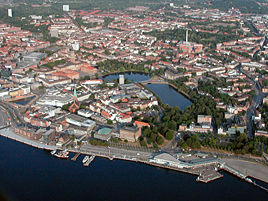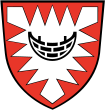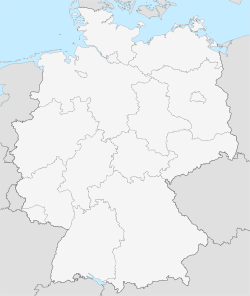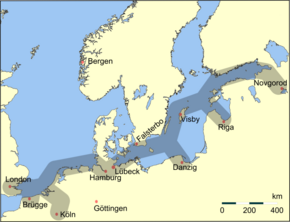Kiel
Kiel ([kiːl]) is the capital and most populous city of the northern German state Schleswig-Holstein. Kiel is approximately 90 km to the north of Hamburg. Due to its geographic location in the north of Germany, the southeast of the Jutland peninsula, and the southwestern shore of the Baltic Sea, Kiel has become one of the main maritime centres of Germany. For instance, the city is known for a variety of international sailing events, including the annual Kiel Week, which is the biggest sailing event in the world. The Olympic sailing competitions of the 1936 and the 1972 Olympic Games were held in Kiel.[1] Kiel has also been one of the traditional homes of the German Navy's Baltic fleet, and continues to be a major high-tech shipbuilding centre. Kiel is an important sea transport hub due to its location at the Kiel Fjord and the busiest artificial waterway in the world, Kiel Canal. A number of passenger ferries to Sweden and other countries operate from here. Within Germany and parts of Europe, the city is known for its leading handball team, THW Kiel. The city is home to the University of Kiel.
HistoryMiddle AgesSt. Niclas' Church was built in the 13th century and is the oldest building in Kiel.
The Kiel Fjord was first settled by Normans or Vikings who would colonize the land along their raids for many years staying in German villages. This is recorded by the geography and architecture of the fjord. Kiel was first originally founded in 1233 as Holstenstadt tom Kyle by Count Adolf IV, and granted Lübeck city rights in 1242 by Adolf's eldest son, John I of Schauenburg.[2] Kiel, the capital of Holstein, was a member of the Hanseatic League from 1284 until it was expelled in 1518 for harbouring pirates. In 1431, the Kieler Umschlag (trade fair) was first held, which became the central market for goods and money in Schleswig-Holstein until it began to lose significance from 1850 on, being held for the last time in 1900. Modern Time
The port and Kiel Fjord.

The Botanical Garden during winter.

Kiel's Opera House
The University of Kiel was founded on 29 September, 1665, by Christian Albert, Duke of Holstein-Gottorp. A number of important scholars, including Theodor Mommsen and Max Planck, studied or taught there. From 1773 to 1864, the town belonged to the King of Denmark. However, because the king ruled Holstein as a fief of the Holy Roman Empire only through a personal union, the town was not incorporated as part of Denmark proper. Thus Kiel belonged to Germany but was ruled by the Danish king. Even though the Empire was abolished in 1806, the Danish king continued to rule Kiel only through his position as Duke of Holstein. When Schleswig and Holstein rebelled against Denmark in 1848 (the First Schleswig War), Kiel became the capital of Schleswig-Holstein until the Danish victory in 1852. During the Second Schleswig War in 1864, Kiel and the rest of Schleswig and Holstein were conquered by a German Confederation alliance of the Austrian Empire and the Kingdom of Prussia. After the war Kiel was briefly administered by both the Austrians and the Prussians, but the Austro-Prussian War in 1866 led to the annexation of Kiel by Prussia in 1867. On 24 March, 1865, King William I based Prussia's Baltic Sea fleet out of Kiel instead of Danzig (Gdańsk). When William I of Prussia became Emperor William I of the German Empire in 1871, he designated Kiel and Wilhelmshaven as Reichskrieghafen, or "Imperial War Harbour". The prestigious Yacht Club of Kiel was established in 1887 with Prince Heinrich of Prussia as its patron. Emperor Wilhelm II became its commodore in 1891. Because of its new role as Germany's main naval base, Kiel quickly increased in size in the following years, from 18,770 in 1864 to about 200,000 in 1910. Much of the old town centre and other surroundings were leveled and redeveloped to provide for the growing city. Kiel was the site of the sailors' mutiny which sparked the German Revolution in late 1918. At the end of World War I the German fleet stationed at Kiel was sent out on a last glorious mission against the Royal Navy. This was a suicide mission that would not have achieved much, so the men stationed on the ships decided they had nothing to lose and refused to leave the relative safety of the port. The lack of response to this from the government was partly to blame for the revolution that soon followed and therefore the rise of the Weimar Republic. Kiel was the site of several camps that provided slave labour for local industry during World War II.[3] Because of its status as a naval port and as production site for submarines, Kiel was heavily bombed by the Allies during World War II. The Bombing of U-boat Pens & Yards destroyed 80% of the remaining old town, 72% of the residential areas, and 83% of the industrial areas.[4] In particular, after the large July 23/24 1944 RAF Bomber Command raid targeting the Deutsche Werke, there was no water for 3 days; trains and buses did not run for 8 days and there was no gas for cooking for 3 weeks.[5] The city was rebuilt after the war. However, Kiel was less meticulously restored than other towns in Schleswig-Holstein like Lübeck, Flensburg, or Schleswig. In 1946, Kiel was named the seat of government for Schleswig-Holstein, and it officially became the state's capital in 1972. The Kieler Umschlag has been held again yearly since 1975. It is now a festival with music and food stalls, historical costumes, special bread, and a wedding, the Umschlagshochzeit for which every young bride and groom can apply. Above all, Kiel is most famous for its Kiel Week sailing festival held annually in June. Main sights
The Opera House (Opernhaus) and the City Hall (Kieler Rathaus).

The Sparkassen-Arena (formerly known as Kieler Ostseehalle) - home ground of THW Kiel.
In the vicinity of Kiel are seaside resorts such as Kiel-Strande, Kiel-Schilksee, Möltenort and Laboe. Laboe has an important naval memorial, as well as the WWII-era submarine U-995, a popular tourist site since 1972. Sights in Kiel include:
EconomyThe Holstenstraße shopping street — Kiel is the largest city in the state of Schleswig-Holstein.
Kiel's economy is dominated by the service sector, transportation, and maritime industry. Kiel is also one of the major ports of the German Navy, and a leading center of German high-tech military and civil shipbuilding. Kiel is the home of HDW Howaldtswerke Deutsche Werft GmbH, a shipyard founded in 1838 famed for its construction of submarines. HDW built the first German submarine Brandtaucher in 1850, and is today a subsidiary of ThyssenKrupp Marine Systems, the leading German group of shipyards. In 2005, the GDP per person was 35,618 €, which is well above the national average of Germany and 159% of the European Union average.[6]
Neighbourhoods
The Schreventeich (Schreven Lake), which is surrounded by a park and close to the inner city, gave Kiel's neighbourhood Schreventeich its name.
The city districts of Düsternbrook, Schreventeich, Ravensberg, and Blücherplatz are popular places to live with many 19th century buildings, villas, and tree-lined streets. The government offices, ministries and parliament of the state of Schleswig-Holstein are also mainly based in these neighbourhoods, particularly Düsternbrook. Transport
Kiel's train station (inside)

The Kiel—Gothenburg ferry.
Kiel has a train station with trains to Hamburg, Lübeck, Flensburg and to locations in Denmark. Kiel is significant port for all shipping companies transporting passengers and goods to the Baltic states. Passenger ferries from Kiel to
Cargo ferries form Kiel to
Notable peoplePeter III of Russia (1728–1762)

Max Planck (1912–2007), physicist

Carl Friedrich von Weizsäcker (1912–2007), physicist and philosopher
Sister townsKiel is twinned with:
See also
References
External links
|
|||||||||||||||||||||||||||||||||||||||||||||||||||||||||||||||||||||||||||||||||||||||||||||




